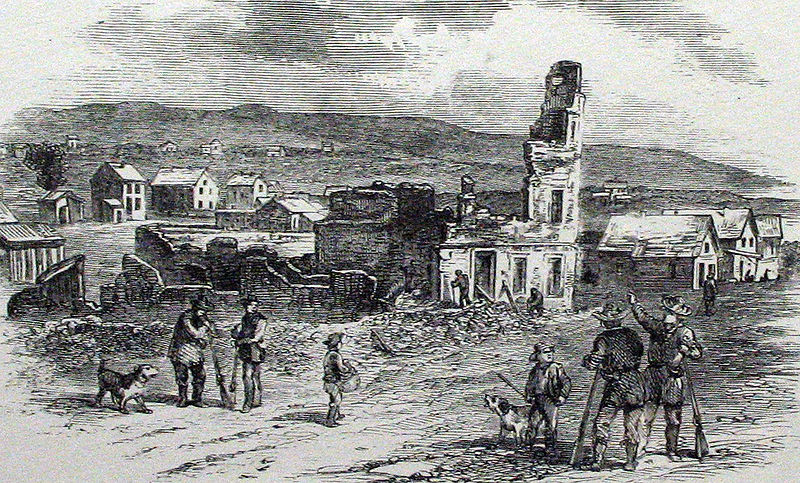By Jeremy Prichard, University of Kansas
The New England Emigrant Aid Company (NEEAC) formed in response to the Kansas-Nebraska Act of 1854. That bill declared that eligible voting residents in Kansas Territory would determine whether the future state would allow or prohibit slavery as a requisite for admission to the Union, creating what became known as popular sovereignty. Antislavery Northerners denounced the act because it essentially repealed the Compromise of 1820, which barred slavery in the lands attained from the Louisiana Purchase above the 36°30’ parallel, including the area that would become Kansas.
One response to the Kansas-Nebraska Act came from businessmen in New England. These men encouraged opponents of slavery to travel to Kansas in order to live and vote in the territory’s elections with the goal of making it a free state. Under the direction of Eli Thayer, a state representative in Massachusetts, the early organizers opposed the expansion of slavery into new lands, but not necessarily the abolition of slavery in states where it already existed. Thayer and other members originally called their group the Massachusetts Emigrant Aid Society, but later decided to change it after finding similar support from other Northeast states. Although the company was organized as a joint-stock enterprise, most of its shareholders viewed the enterprise as a charity with little expectation that they would get much return on their investment.
The first arrivals, including many from cities who had little working knowledge of agriculture or farming, struggled to establish themselves in Kansas with its scarce frontier resources.
The NEEAC provided funds to Kansas-bound settlers to help alleviate travel expenses, sometimes paying upwards of 25 percent of the overall cost per individual. The company also equipped emigrants with resources to develop the land and ease their transition to the new surroundings. Despite these efforts, some migrants encountered high costs along the journey and upon entering the territory. The first arrivals, including many from cities who had little working knowledge of agriculture or farming, struggled to establish themselves in Kansas with its scarce frontier resources. These early obstacles convinced some to return east, leaving those with stronger political convictions to endure the sacrifices of making Kansas a free state.
The Northern settlers, who began arriving in 1854, founded various towns such as Topeka, Manhattan, and Osawatomie. The organization established its regional headquarters in Lawrence, named in honor of NEEAC treasurer Amos Lawrence. The town became an abolitionist stronghold in the territory, and the 1856 Sack of Lawrence by border ruffians was a result of the NEEAC’s prominence there.
From the moment of their arrival, Northern emigrants clashed with Missourians who wanted Kansas to become a slave state. The proslavery opponents of the NEEAC exaggerated the number of settlers associated with the organization and believed that it sent Northern settlers to Kansas to vote in the territory’s elections only to return to the East after the ballots had been counted. Free-Soil proponents assumed (correctly, in many instances) that their opponents were similarly crossing over the Missouri-Kansas border to vote in elections, escalating tensions between the two sides.
From the moment of their arrival, Northern emigrants clashed with Missourians who wanted Kansas to become a slave state.
To protect its settlers, the NEEAC clandestinely armed men and sent Sharp’s rifles to the territory in cases marked “Bibles” and “Books,” often referred to as “Beecher’s Bibles” in reference to Henry Ward Beecher, a prominent abolitionist minister and brother of Harriet Beecher Stowe, author of Uncle Tom’s Cabin. With these weapons, antislavery emigrants formed militias to defend themselves, particularly in land disputes with border ruffians. Northern settlers associated with the NEEAC were well-armed before the major fighting of Bleeding Kansas broke out.
The NEEAC had a mixed legacy. It was not profitable, and fewer than 2,000 settlers allied with the organization arrived in Kansas. Many of those settlers were also Midwestern farmers aided by the organization. However, its actions encouraged the development of subsequent aid societies that provided funding for anyone who wanted to travel to Kansas to make it a free state. All of this activity promoted more Northern migration into the territory, which allowed antislavery residents to outnumber their proslavery counterparts in the territory in less than two years after the Kansas-Nebraska Act. Some of the territory’s—and eventually the state’s—prominent leaders got their start with the NEEAC.
After Free-State candidates gained a majority in the territorial legislature in 1857, the NEEAC reduced its funding commitments to Kansas. Owners back East disagreed over how much should be spent on continued settlement in the territory. They also split over appropriate responses to the fighting in Kansas, with some preferring peaceful efforts and others supporting abolitionist John Brown’s violent tactics. After reducing its commitment in Kansas, the company endured during the Civil War and beyond. Hoping to offset its financial losses from the 1850s, the new leadership envisioned the company playing a role in the postwar period by promoting Northern migration to the former Confederate states. The NEEAC’s charter was renewed in 1867, but it was mostly inactive in the years leading up to its official termination on February 19, 1907.
Suggested Reading:
Etcheson, Nicole. Bleeding Kansas: Contested Liberty in the Civil War Era. Lawrence: University Press of Kansas, 2004.
Harlow, Ralph Volney. "The Rise and Fall of the Kansas Aid Movement," The American Historical Review. vol. 41, no. 1 (October 1935): 1-25.
Johnson, Samuel A. "The Genesis of the New England Emigrant Aid Company," The New England Quarterly. Vol. 3, no. 1 (January 1930): 95-122.
Cite This Page:
Prichard, Jeremy. "New England Emigrant Aid Company" Civil War on the Western Border: The Missouri-Kansas Conflict, 1854-1865. The Kansas City Public Library. Accessed Thursday, April 25, 2024 - 17:03 at https://civilwaronthewesternborder.org/encyclopedia/new-england-emigrant...


